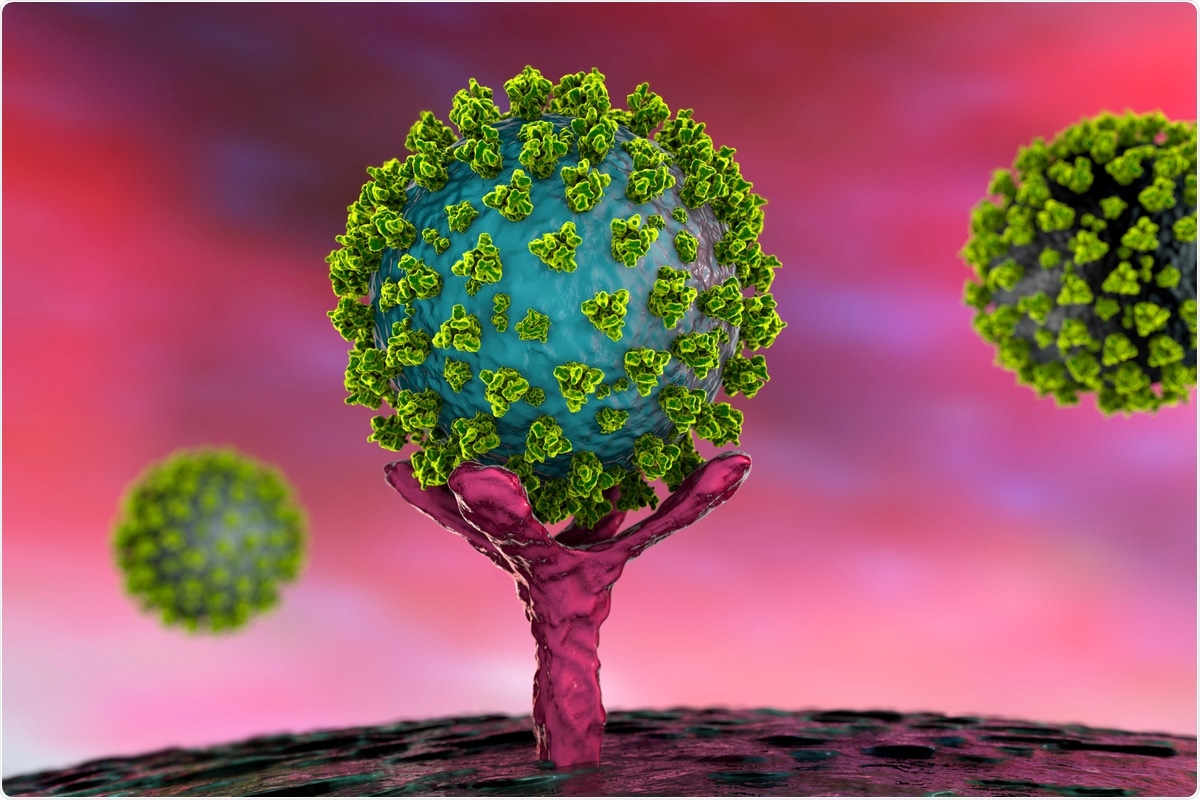The rapid outbreak of the severe acute respiratory syndrome coronavirus 2 (SARS-CoV-2) has resulted in the coronavirus disease 2019 (COVID-19) pandemic. COVID-19 is continuing to spread worldwide. An estimated 15% of patients, mostly with immunodeficiency, were seen to develop severe cases due to rapid viral vascular leakage and subsequently disseminated viremia. Controlling the viral load is essential to reduce COVID-19 mortality and improve severe illness treatment.
 Study: Inhaled ACE2-engineered microfluidic microsphere for intratracheal neutralization of COVID-19 and calming of the cytokine storm. Image Credit: Kateryna Kon/ Shutterstock
Study: Inhaled ACE2-engineered microfluidic microsphere for intratracheal neutralization of COVID-19 and calming of the cytokine storm. Image Credit: Kateryna Kon/ Shutterstock
Background
Vaccines and neutralizing antibodies are the current strategies to combat SARS-CoV2 infection. These treatments prevent the binding of the spike (S) protein to the host’s angiotensin-converting enzyme II (ACE-2) receptor. These approaches are effective, but there are some inherent problems. Vaccines require time to develop and are, therefore, not an emergency solution.
The upper respiratory tract contains pervasive ACE-2 expressing cells and is often neglected as an infection pathway. Viruses in the upper respiratory tract, especially the delta variant, are shed into saliva, enter the environment, and cause rapid inter-human contamination. Current strategies target a particular viral species and not the affected host cells. Therefore, neutralizing antibody- or vaccine-resistant viruses emerge owing to SARS-CoV-2 mutations. Ignoring the upper respiratory infection highlights the fact that current vaccines and neutralizing antibodies are not sufficient.
Existing approaches do not effectively inhibit SARS-CoV-2 infection and replication in the upper respiratory tract, especially the nasopharynx. This passage serves as the initial site of SARS-CoV-2 invasion, shows a higher viral load, and subsequently passes infection onto the lung. Existing therapeutic options also focus only on eliminating the SARS-CoV-2 itself while ignoring other important factors such as anti-inflammatory interventions, especially in patients with immune distress.
A new study has been published in Matter that develops an inhaled microfluidic microsphere with a genetically engineered membrane from the ACE2 receptor-overexpressing cells and macrophages.
A new study
Taking inspiration from the process of virus infection from the host point of view, scientists developed a microfluidic microsphere-based inhaled aerosol (iAE-PMS) to prevent SARS-CoV-2 infection. It is manufactured using FDA-approved dual camouflaged methacrylate hyaluronic acid hydrogel microspheres with bioactive membranes from the ACE2 receptor. A huge advantage of the iAE-PMS is related to its ability to distribute simultaneously over the entire respiratory system, including the nasopharynx, trachea, bronchus, and alveolus.
HEK293-ACE2 cells with a high level of ACE2 expression were successfully constructed using an imported ACE2 gene vector. Subsequently, the human ACE2 gene was inserted into the PCNDA3.1-3XFlag-C vector. This resulted in the ACE2- PCNDA3.1-3XFlag-C vector, which was then introduced into HEK293- ACE2 cells. Scientists confirmed the high level of ACE2 expression on HEK293-ACE2 cells by immunofluorescence imaging and quantitative analysis.
Main findings
Scientists observed that the protective activity against viral infection of iAE-PMS increased from 9.28% to 91.33%. This corresponded to 10 times higher efficacy than a blank control. In the treatment of COVID-19, fulminant inflammation and direct infection of SARS-CoV-2 are also key and cannot be ignored to save the lives of critically ill patients. In vitro studies were performed, in which researchers observed encouraging results with respect to the impact of iAE-PMS on broad-spectrum neutralization of inflammatory cytokines, involving TNF-a, IL-1b, and IL-6.
Furthermore, inhaled aerosols can reduce lung damage significantly by bringing about a regulated landscape of lung-infiltrated immune cells. The lung-damaging microenvironment comprises M1 macrophages, neutrophils, and cytotoxic T cells. The aerosol was administered (intratracheal) in vivo to mice with acute pneumonia. Scientists observed that the aerosol alleviated the hyperinflammatory state significantly by draining the lymph nodes and the spleen. This improved the survival ratio from 7.35% to 56.74%. iAE-PMS could, therefore, be a potent strategy to treat patients with severe COVID-19 by means of non-invasive selective lung-localized administration.
.jpg) Graphical Abstract: Inhaled ACE2-engineered microfluidic microsphere for intratracheal neutralization of COVID-19 and calming of the cytokine storm
Graphical Abstract: Inhaled ACE2-engineered microfluidic microsphere for intratracheal neutralization of COVID-19 and calming of the cytokine storm
Conclusion
The SARS-CoV-2 pandemic spread worldwide unabated, and its trajectory is still quite uncertain. Gaining protection against the virus in the whole respiratory tract and calming the subsequent cytokine storm remains a major challenge that scientists are grappling with.
In this study, scientists have developed an inhaled microfluidic microsphere, which has demonstrated the capacity to significantly reduce SARS-CoV-2 infective effectiveness over the whole course of the respiratory system in vitro and in vivo. In an acute pneumonia model, microspheres showed significant therapeutic efficacy and reduced acute mortality. These are encouraging results that put forward a new powerful synergic strategy to treat severely ill COVID-19 patients.
- Wang, Z. et al. (2021) "Inhaled ACE2-engineered microfluidic microsphere for intratracheal neutralization of COVID-19 and calming of the cytokine storm", Matter. doi: 10.1016/j.matt.2021.09.022. https://www.cell.com/matter/fulltext/S2590-2385(21)00467-7?_returnURL=https%3A%2F%2Flinkinghub.elsevier.com%2Fretrieve%2Fpii%2FS2590238521004677%3Fshowall%3Dtrue
Posted in: Medical Science News | Medical Research News | Disease/Infection News
Tags: ACE2, Angiotensin, Antibodies, Antibody, Anti-Inflammatory, Contamination, Coronavirus, Coronavirus Disease COVID-19, Cytokine, Cytokines, Efficacy, Enzyme, Gene, Hydrogel, Imaging, Immunodeficiency, in vitro, in vivo, Inflammation, Lymph Nodes, Membrane, Mortality, Neutrophils, Pandemic, Pneumonia, Protein, Quantitative Analysis, Receptor, Respiratory, SARS, SARS-CoV-2, Severe Acute Respiratory, Severe Acute Respiratory Syndrome, Spleen, Syndrome, Vaccine, Vascular, Virus

Written by
Dr. Priyom Bose
Priyom holds a Ph.D. in Plant Biology and Biotechnology from the University of Madras, India. She is an active researcher and an experienced science writer. Priyom has also co-authored several original research articles that have been published in reputed peer-reviewed journals. She is also an avid reader and an amateur photographer.
Source: Read Full Article
